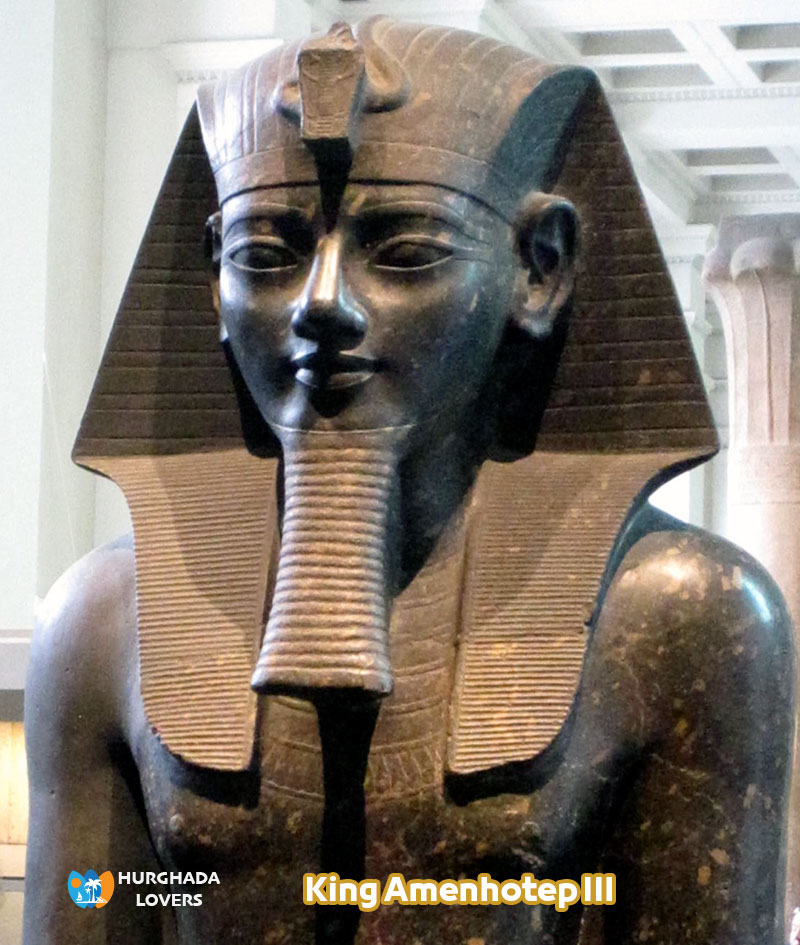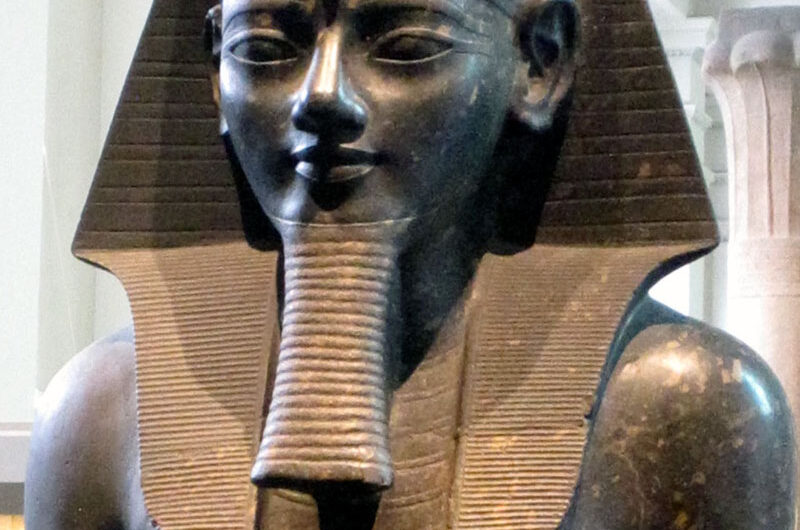King Amenhotep III – Egyptian Pharaohs kings – Eighteenth Dynasty of Egypt – The New Kingdom
“Amenophis III, Amenhotep the Magnificent, Amenhotep the Great” | Facts & History The Greatest of Egyptian Pharaohs kings Life | Secrets, Biography, Accomplishments in Ancient Egypt, Tomb, Mummy, Life and Death of the King, the Eighteenth Dynasty of Egypt and more about Ancient Egypt History.
King Amenhotep III, pharaohs of ancient Egypt, also called Amenophis III, is the ninth individual in the Eighteenth Dynasty and is one of the greatest rulers who passed through Egypt throughout history. His rule was from 1391 to 1353 BC. Learn more King Amenhotep III.
Ruling period: 1391–1353 BC
Duration of rule in Ancient Egyptian Government: 38 years.
Father: King Thutmose IV
Mother: Queen Mut Mweya, the most famous Pharaonic queen of Egypt “Female Pharaohs“.
Wife: Queen Tiye, Queen Sitamun, Queen Gelioheba, Queen Tudukheba
Children: King Akhenaton, Prince Thutmose, Princess Sat-Amun, Princess Est, Princess Henutta-neb, Princess Nebt-ah, king Smenkhkare, Prince Bakket-Aten
Archaeology:
- Stone statues to indicate the development of the craft of Sculpture in Ancient Egypt and the development of Architecture in ancient Egypt.
- The Tomb of Amenhotep III | KV22 / WV22 in the Valley of the Kings Tombs in Luxor, Thebes, southern Egypt
- Al Malqa Palace,
- Mortuary Temple of Amenhotep III.
- Statue of Memnon,
- A temple to God Montu, a temple of God Mut, the most famous ancient Egyptian deities, and the third edifice in the Karnak Temple complex.
- Temple of Amenhotep III in El Kab
King Amenhotep III Facts :
- King Amenhotep III is considered the most famous king of the Pharaohs and the owner of the largest architectural renaissance in the era of The New Kingdom in ancient Pharaonic Egypt, where many Egyptian Temples, Pharaonic Egyptian Tombs, and projects were built inside ancient Egypt, He was interested in developing Astronomy in ancient Egypt, Ancient Egyptian science and Medicine in ancient Egypt.
- He married Queen Tiye, the most famous Pharaonic queen of Egypt “Female Pharaohs” throughout history, and she was distinguished by her strong personality and wisdom in managing the country’s affairs with him. Her name was engraved with him on all the walls and huge statues of the same size as her husband were carved in the funerary Mortuary Temples in Luxor “It indicates interest in religious beliefs and rituals, as in the Ancient Egyptian religion“. He had a second wife called Queen Sitamun.
- The Pharaonic king had only two sons, King Thutmose, who died young, and the other, King Amenhotep IV, “King Akhenaton,” the father of King Tutankhamun “Tomb of Tutankhamun | KV62″.
- He declared himself a deity within the Religious rituals in the Pharaonic and Ancient Egyptian gods and Goddesses after his first Sed festival, the “Festivals in Ancient Egypt”, where huge celebrations were held on the occasion of the thirtieth anniversary of the king’s rule on the throne of Egypt, where the king participated in the celebration in many Pharaonic Ancient Egyptian Sport games to renew his activity and display his strength to Ancient Egyptians.
- King Amenhotep III married and had several sons, including Akhenaten, Prince Thutmose, Sat Amun, Est, and Henhout Tabneb.
- The king also begot Nebethah, Semenkhkare, and Beketten.
- The father of King Amenhotep is Thutmose IV, while the mother is the death of Em and Ya.
- He died in 1353 BC, but some Egyptologists say that he died in 1351 BC, and was buried in tomb No. 22.
- The meaning of the name Amenhotep or Amunhotep, which means Amun Radi. There is also another name, Amenhotep, really Wasit, which means Amenhotep, the ruler of Thebes.
King Amenhotep III ruled
- King Amenhotep III was interested in sports such as hunting and hunting at the beginning of his reign.
- Where the king was a skilled hunter, and there is a Pharaonic Scarab that is recorded as having managed to hunt 100 wild bulls in just two days.
- There is also another scarab dating back to the tenth year of his reign, which shows that the king managed to hunt 102 lions from his hunting trips.
- He was also interested in military operations “Military of ancient Egypt“, and this is evident in his confrontation with the unrest in the fifth year of his reign, and that confrontation was in the region of Kush.
- The king defeated them and expanded his influence until it reached the fourth cataract. This confrontation was recorded in a memorial near the island of Konosu in Nubia as in Geography of ancient Egypt.
- There is also a painting “Fatness”, which explains the king’s suit on Nubia, and the painting is now located in The British Museum.
- Abhat, which is located after the second waterfall in Nubia, witnessed a revolution and was led by the king’s son of Kush, and Amenhotep sent his deputy to suppress that Revolutions in Ancient Egypt.
Monuments
- King Amenhotep III was also interested in building temples for him, as he built a temple for him in Thebes, but it was completely destroyed after that.
- It was not the only temple for him in Thebes, for good luck, and Karnak also contained a temple for the king, where he built a temple for the god Montu, the ancient Egyptian god of war.
- The king also built a temple for the goddess, Mut, the wife of God Amun-Ra as in Egyptian Mythology and Ancient Egyptian Literature. He also participated in the construction of Amun located in Karnak, where he built the third edifice located in the temple.
- Since the king’s mother was a foreigner, the king wanted to show his devotion to the god Ra and built a temple for him in Karnak.
- There is in Thebes a mortuary temple of King Amenhotep, which is one of the greatest that the king built.
- A group of Egyptian Antiquities were found, including those found in the Delta, Banha, Giza and Memphis.
- Other antiquities were also found in Armant, Sinai, and the Tombs of El Kab Or Elethya region in Aswan.
- He also has two seated statues and they are called Colossi of Memnon, and red sandstone “Ancient Egyptian Metallurgy” was used to make one of the statues, It indicates the development of Industry in ancient Egypt.
- The height of a statue of them is 15 meters. It was supervised by the engineer Amenhotep, son of Hapu and was located in front of the King’s Mortuary Temple to decorate it.
- The two statues are currently in their place on the way to reach the Tombs of the Kings in the cemetery.
- In an earthquake in 27 BC, the northern statue was split in half and was making sounds as a result of changes in humidity and temperature.
- The ancient Egyptians believed that these sounds are the lamentation of the mother of the Ethiopian hero called Memnon, who fell dead in Troyda Square.
- There is a group of memorial scarabs belonging to King Amenhotep III and there are so far five of them.
- Temple of Amenhotep III in El Kab
The family
- King Amenhotep III married Queen Tiye in the second year of his reign.
- The queen gave birth to Amenhotep IV, his successor to power, who later called himself Akhenaten, uniting religions and deities and going to Tell el-Amarna in Al Minya.
- That was not the only wife of the king, but he had another set of wives, and they were for diplomatic purposes, such as Prince “Gluchiba” and the daughter of the King of Iraq.
- He also gave birth to Thutmose, but he died during the life of King Amenhotep, and it is known that he had 6 sons.
Tomb of King Amenhotep III
- King Amenhotep III died after ruling Egypt for nearly 38 years.
- The king was at the age of fifty, and some say that the cause of death was a disease.
- The tomb was discovered in 1799 and bears the number 22 and is located in the Valley of the Kings.
- EgyptologyJoloh and Devile found the tomb, but it was found empty, with walls cracked and destroyed due to climatic factors.
- The mummy of the king was not inside, but it was later found in a tomb near Deir El Bahari in 1881, and it was hidden by the priests “High Priest of Amun“.
Ancient Egyptian deities:
It is a depiction of the religious belief of worship, and the deities were drawn with a human body with the head of an animal, which indicates certain characteristics, such as the God Thoth, the symbol of wisdom, and the God Ra, the symbol of the sun, the God Horus, and so on. Of the gods and religious beliefs of the ancient Egyptians.
Note: Facts and secrets of the history of the Pharaoh kings will be added soon…
Hurghada Excursions Lovers, Best Travel Agency in Hurghada to provide daily tours to visit the Tourist attractions of Luxor by Hurghada to Luxor Tours and Hurghada to Pyramids Trips. Book online when you come to Hurghada, El Gouna, Sahl Hashish, Makadi Bay, Soma Bay, Egypt.

